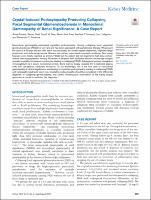Crystal-Induced Podocytopathy Producing Collapsing Focal Segmental Glomerulosclerosis in Monoclonal Gammopathy of Renal Significance: A Case Report

View
Author
Date
2021-07Permanent link
https://hdl.handle.net/11351/7054DOI
10.1016/j.xkme.2021.03.007
ISSN
2590-0595
WOS
000685916200023
PMID
34401732
Abstract
Monoclonal gammopathy–associated crystalline podocytopathy causing collapsing focal segmental glomerulosclerosis (FSGS) is very rare and has been associated with pamidronate therapy. We present the case of a 53-year-old man with vision loss secondary to corneal crystals deposition, nephrotic-range proteinuria, and reduced glomerular filtration rate without associated comorbid conditions. Two kidney biopsies were initially reported as primary FSGS but the patient did not respond to high-dose corticosteroid immunosuppression therapy. Re-review of biopsies with additional electron microscopy analysis revealed crystalline inclusions in podocytes leading to collapsing FSGS. Subsequent workup revealed an immunoglobulin G κ serum monoclonal protein. Bone marrow biopsy revealed 5% κ-restricted plasma cells with cytoplasmic crystalline inclusions. To our knowledge, this is the first case of monoclonal gammopathy of clinical significance manifesting as crystalline podocytopathy leading to collapsing FSGS and keratopathy leading to vision loss. Crystalline podocytopathy should be considered in the differential diagnosis of collapsing glomerulopathy, and careful ultrastructural examination of the kidney biopsy specimen is crucial to establish this diagnosis.
Keywords
Focal and segmental glomerulosclerosis; Crystalline keratopathy; PodocytopathyBibliographic citation
Buxeda A, Said S, Nasr SH, Soler MJ, Howard MT, Maguire LJ, et al. Crystal-Induced Podocytopathy Producing Collapsing Focal Segmental Glomerulosclerosis in Monoclonal Gammopathy of Renal Significance: A Case Report. Kidney Med. 2021 Jul;3(4):659–64.
Audience
Professionals
This item appears in following collections
- HVH - Articles científics [4476]
The following license files are associated with this item:

 Private area
Private area Contact Us
Contact Us






